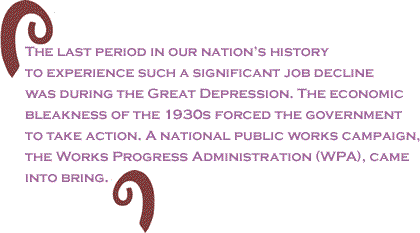|
If
President Obama is serious about our youth, then he must
act now. At no time in the past 55 years have so few black
male teens worked, when compared to their percentage of
their population. Comparatively, if employment rates
for adults were to face a similar decline, our country would
have to declare a state of national emergency. Proven strategies
exist for increasing the employment prospects for the nation’s
teens and young adults. Some of these strategies include
public job creation programs and year-round subsidized jobs
for youth in the private sector and public sectors. By investing
in said strategies, the President has an opportunity to
connect to the country’s most marginalized youth and put
them on the pathway to future economic success.

The
last period in our nation’s history to experience such a
significant job decline was during the Great Depression.
The economic bleakness of the 1930s forced the government
to take action. A national public works campaign,
the Works Progress Administration (WPA), came into being.
Thousands of adults were put to work building much needed
bridges, roads and tunnels. The term “shock and awe” took
on new meaning. My point? If the country could do it then
to increase adult employment rates and reboot the economy,
why can’t they do it now?
The Work Progress Administration (WPA) was a relief measure
established in 1935 that lasted through 1943. During this
time, billions of dollars were invested in creating work
for people greatly affected by the depression. It
offered work, on an unprecedented scale, to the unemployed
on a wide variety of programs; including highways and building
construction, slum clearance, reforestation, and rural rehabilitation.
The WPA had employed more than 8,500,000 different persons
on 1,410,000 individual projects, and had spent about $11
billion. During its 8 eight year history, the WPA built
651,087 miles of highways, roads, and streets and constructed,
repaired, or improved 124,031 bridges, 125,110 public buildings,
8,192 parks, and 853 airport landing fields.
Interestingly, one of WPA’s most notable projects was Federal
One. Federal One was comprised of five major divisions:
the Federal Art Project, the Federal Music Project, the
Federal Theatre Project, and the Federal Writers Project
. Just one year after its inception, some 40,000 WPA artists
and other cultural workers were employed in projects throughout
the United States.

The project placed unemployed artists, musicians, actors
and writers in positions on various projects throughout
the United States on various projects, including working
in settlement houses as teachers. Federal One not only provided
work for artists, writers, musicians, and actors, but nurtured
young men and women who were embarking on a career in the
arts during the Great Depression. Many well known writers
and artists were able to develop their talents as a result
of Federal One. The WPA rolls had reached 2,300,000 monthly
by June 30, 1943, when it was officially terminated.
Think of the possibilities that would bloom if the government
would were to launch a similar effort, a “Federal Two,”
but this time focusing on every young unemployed wannabe
rapper, break dancer, rock star or skateboarder, and engaging
them in projects focused on promoting education and opportunity
throughout the urban and rural areas of the U.S.- think
of the possibilities. When faced with a serious employment
crisis, this country responded by engaging people in the
subjects of their interest, not that those of the government’s.
Today, there is another crisis, and we need a similar
reaction.
BlackCommentator.com
Guest Commentator Edward DeJesus is a national youth development
expert. He works with youth programs and young people in
most of the major cities in the U.S., including D.C., Los
Angeles, and New York City. Click here
to contact Mr. DeJesus. |

